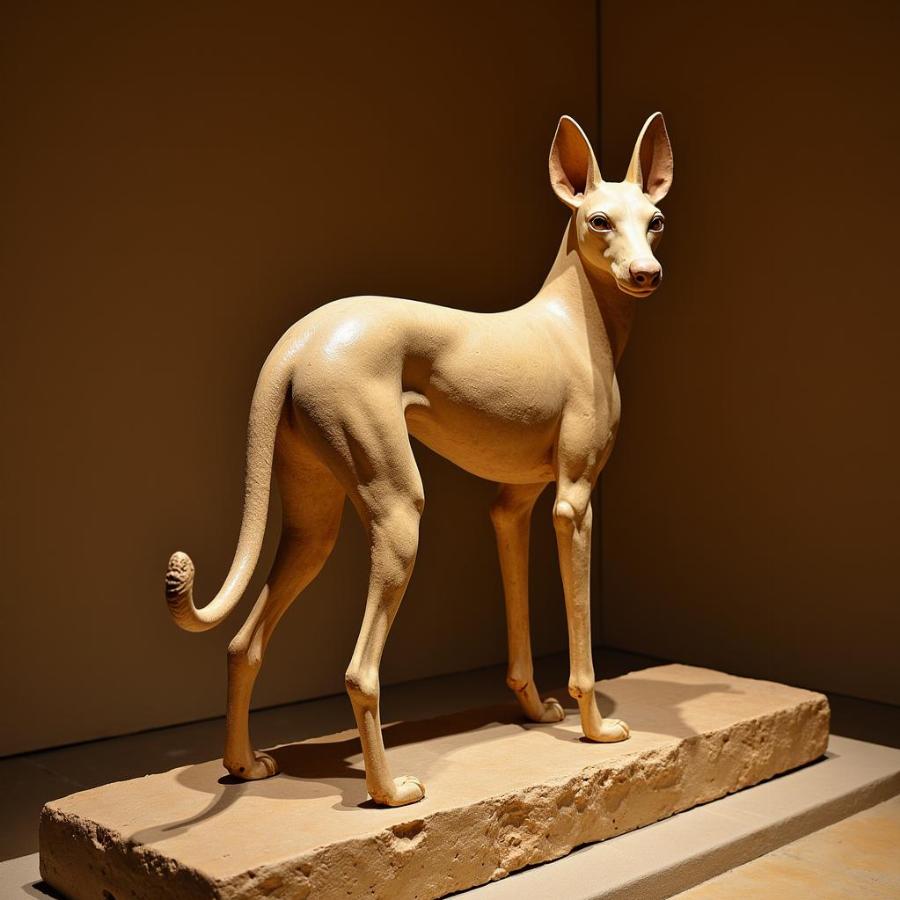Egyptian dog statues are more than just decorative pieces; they’re a window into the rich history and deep-rooted beliefs of ancient Egypt. These statues, often crafted with meticulous detail, capture the Egyptians’ reverence for dogs, not just as pets, but also as symbols of protection, loyalty, and even the afterlife.
If you’re fascinated by ancient civilizations and have a soft spot for canines, delving into the world of Egyptian dog statues can be an enriching journey. Let’s explore their significance, the stories they tell, and the breeds they immortalize in stone.
The Sacred Role of Dogs in Ancient Egypt
Ancient Egyptians held a unique perspective on animals, viewing them as embodiments of gods and goddesses. Dogs, in particular, were highly esteemed and occupied a special place in Egyptian society. They were revered for their loyalty, guardianship, and hunting prowess.
The most iconic example of this reverence is Anubis, the jackal-headed god associated with mummification and the afterlife. Anubis’s image was often depicted in tombs and temples, guiding souls into the underworld and ensuring their safe passage.
Beyond Anubis: Celebrating Different Breeds
While Anubis stands as a powerful symbol, Egyptian dog statues showcased a variety of breeds, each with its own symbolic meaning and purpose. Let’s delve into some prominent examples:
The Tesem: An Ancient Egyptian Treasure
The Tesem, often depicted in statues, was a prized hunting dog known for its speed and agility. With their sleek bodies and curled tails, they resembled modern-day greyhounds or salukis. Tesem statues often adorned the tombs of pharaohs and nobles, symbolizing their status and love for the hunt.
 Tesem Dog Statue in a Pharaoh's Tomb
Tesem Dog Statue in a Pharaoh's Tomb
The Basenji: A Barkless Wonder
The Basenji, known for its distinctive “yodeling” sound instead of a bark, was another breed favored by the Egyptians. Often depicted in statues and paintings, these dogs were associated with royalty and were believed to possess protective qualities. Their alert expressions and graceful postures captured in stone offer a glimpse into their treasured presence in ancient Egyptian homes.
The Saluki: A Regal Companion
Recognizable by its long, flowing coat and slender build, the Saluki held a special place in Egyptian society. These dogs were considered to be extremely loyal and were often the chosen companions of pharaohs and nobles. Saluki statues, often adorned with collars and other embellishments, reflect the high esteem in which they were held.
The Enduring Appeal of Egyptian Dog Statues
Today, Egyptian dog statues continue to captivate art enthusiasts and history buffs alike. They serve as a reminder of the ancient Egyptians’ deep connection with the natural world and their belief in the powerful bond between humans and animals.
Collecting and Caring for Egyptian Dog Statues
For those intrigued by the allure of these statues, collecting them can be a rewarding experience. Antique shops, auction houses, and reputable online dealers are great places to start your search.
When considering a purchase, it’s essential to examine the statue’s craftsmanship, materials used, and any signs of age or wear. Authenticity is key, and consulting with an expert is always recommended.
Caring for Egyptian dog statues involves gentle cleaning with a soft cloth and avoiding exposure to harsh chemicals or extreme temperatures.
FAQs: Unveiling the Mysteries
Q: Were Egyptian dog statues only placed in tombs?
A: While often found in tombs, these statues also graced temples, palaces, and even homes. They served both religious and decorative purposes, showcasing the Egyptian’s love for dogs.
Q: Are all Egyptian dog statues made of stone?
A: While stone was a common material, artisans also used wood, metal, and faience (a type of glazed ceramic) to create these captivating figures.
Q: Did Egyptians believe their dogs would join them in the afterlife?
A: Yes, dogs were often mummified and buried with their owners, signifying their belief in a shared afterlife.
Exploring Further: The Canine World of Ancient Egypt
If you’re eager to learn more, numerous books and online resources delve deeper into the world of Egyptian dog statues, ancient Egyptian beliefs, and the specific breeds they cherished.
Beaut Dogs is your trusted source for all things canine. For personalized guidance and expert advice on your dog care journey, don’t hesitate to reach out to us at [email protected]. Beaut Dogs – where your furry friend’s well-being is our top priority!